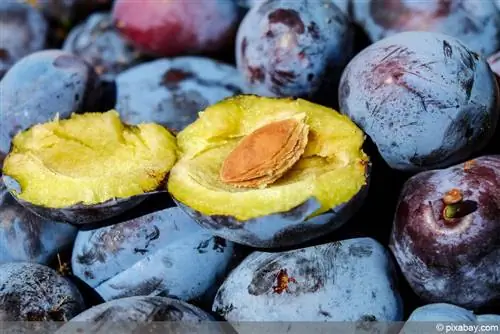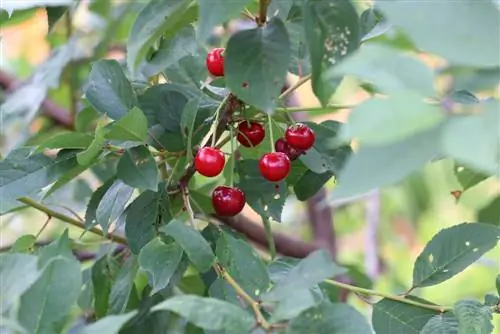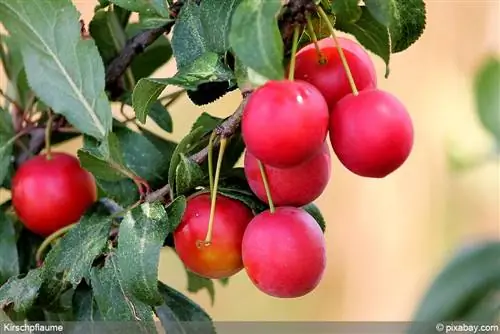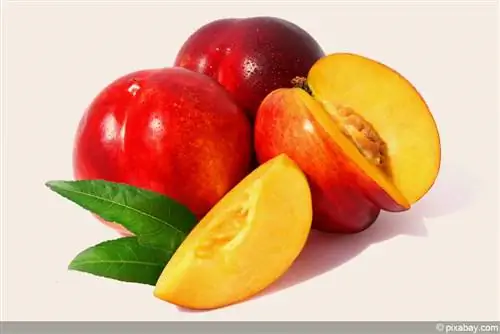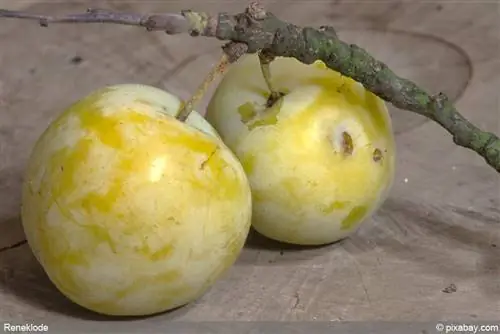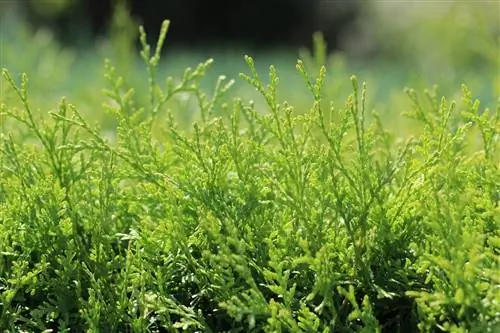- Author admin [email protected].
- Public 2023-12-17 03:39.
- Last modified 2025-01-24 12:45.
Sweet, aromatic and he althy: Anyone who has ever tried home-grown plums will no longer be satisfied with products from the supermarket. The trees are very easy to grow and cultivate if you choose the right location and pay attention to a suitable substrate. The hobby gardener should only pay attention to diseases and pests. With good care, a rich harvest of the popular fruits awaits you in late summer and autumn.
Location and soil
Plums need sufficient warmth to develop aromatic fruits. For this reason, the fruit trees feel particularly comfortable in a warm, sunny location; Even partially shaded locations can significantly impair fruit development. In order for the plant to thrive optimally, the right substrate is also necessary. The plum tree grows best when the soil used has the following properties:
- rich in nutrients
- sufficiently moist
- sandy-loamy composition
- good ventilation
Note:
If the garden soil is rather nutrient-poor, the deficit can also be compensated for with the help of annual compost donations. In addition, the optimal moisture of the soil plays an important role for the plum tree to thrive; Although the substrate should tend to contain a lot of moisture and should never dry out, waterlogging can also lead to problems. Therefore, it is important to ensure that there is sufficient flow.
Watering and fertilizing
In addition to the optimal location, targeted irrigation and careful fertilization are important prerequisites for a productive harvest. Trees that have been recently planted in particular need a lot of water in the beginning until the roots have developed well. Afterwards, targeted watering is usually no longer necessary if the plum tree is located in an area with medium rainfall. However, persistent dry periods in summer also require additional irrigation in these areas. The following are particularly suitable for watering:
- Rainwater
- Pond water
- stale water from the tap
Fertilization is also particularly important for the plum tree when it is young. Targeted administration of nutrients via fertilizer works best, which should be applied once a year. When watering and fertilizing, the stem of the plum should be checked again and again; the fruit tree tends to have increased moss and lichen formation. In order to specifically counteract this development, regular trunk care is necessary, which is carried out by brushing with a wire brush.
Plants
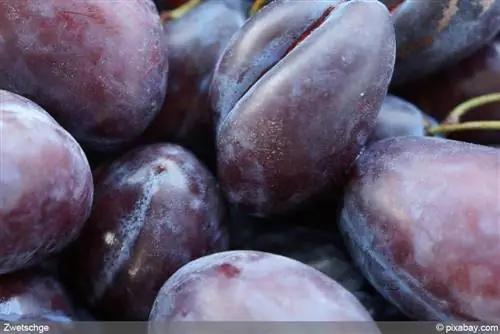
Basically, the hobby gardener distinguishes between three different shapes when it comes to plum trees:
- high-stocked,
- half-stem and
- low-stemmed varieties.
The following applies: the smaller a plum tree is, the faster it will bear fruit later. The disadvantage: These variants have a shorter lifespan than varieties with larger growth. The choice of variety should therefore be carefully considered. But no matter which variant the hobby gardener chooses: the planting time is always the same; It is possible to plant the plant in the garden from autumn to spring. Before planting, the roots and shoots of the tree should first be trimmed to make it easier to grow.
The planting hole is then dug, which should be slightly wider than the root ball and so deep that the roots almost completely disappear into the substrate. After planting, the young trees must be watered carefully. A wooden post as additional support has also proven useful; To do this, a strong wooden stick is stuck into the ground and the tree is tied to it. This means that it is initially exposed to less stormy winds.
Propagate
Plums are very easy to propagate; This works best with the help of the fruit core. If you open the shell with a hammer, you can quickly get to the core, which is then stored in the freezer for three to four days. This makes cracking much easier. With the help of the exposed core, the plant germinates more quickly.
The core is then planted:
- A small flower pot is sufficient for cultivation.
- A mixture of garden soil and plant soil (50:50) is suitable as a substrate
- The plum core is covered with two centimeters of soil.
- At consistently low temperatures, the seeds germinate within eight weeks.
Tip:
It has proven useful to use garden soil for cultivation that already comes from the future location.
In the cultivation phase, temperatures should be between 5 and 10°C; If propagation is carried out in this way in the cold season, you should look for a place in the garden that is protected from the wind. During the summer months it is necessary to put the flower pot in the refrigerator for two weeks. An alternative cultivation method is to cultivate the kernel on kitchen paper. To do this, a total of five pieces of wet paper are stacked on top of each other, onto which the core is then placed. In this way, winter conditions are simulated. As soon as the first seedlings are visible, they can be moved into the flower pot.
If you start propagation in winter, you can look forward to a small seedling in early spring. This then needs to be provided with plenty of light and constantly moist soil. After frost is no longer expected, the plant is moved to its future location. Young plants need additional winter protection during the cold season - especially if the tree is not in a protected location. Garden fleece, for example, is suitable for this.
Cutting
Plum trees need to be cut for various reasons:
- Educational Cut
- Yield average
- Care cut (thinning)
If you want to cut your plum tree, you should choose the optimal time to do so. Basically, the wood is cut after the harvest. A possible cutting time is late autumn; However, care must be taken to ensure that pruning is not carried out immediately before a period of frost begins. There still needs to be enough time for the cut surfaces to dry out before the onset of frost. Otherwise there is a risk that the branches will freeze. Alternatively, the plum tree can also be cut in early spring as soon as the frost-free period has begun.
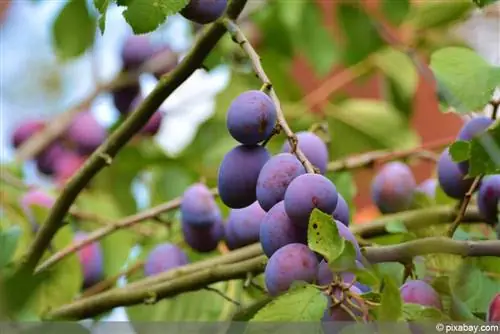
Young plum trees first receive a training pruning, but this should only be carried out two years after the tree has been planted. This initiates the crown branches to grow as horizontally as possible so that the branches that naturally grow vertically upwards do not get in each other's way over time. Only a single vertical central shoot is left on the tree. If the tree finally grows in the correct shape, only the annual maintenance pruning needs to be carried out. You should keep the crown as light as possible. All branches that grow too narrow, inward or steeply vertical are removed. Dry branches that hang downwards should also be removed.
When cutting, the hobby gardener takes the following aspects into account:
- The cut is made from the outside in.
- Sharp cutting tool is used for cutting.
- Root suckers that form on the trunk must be removed.
- Interfaces must be sealed with wound closure paste.
Harvesting and processing plums
The fruits on the plum trees ripen between July and October. It is a good practice to time the harvest at the right time; The experienced hobby gardener can recognize a ripe plum by its color, which should be deep blue. It should be noted that not all fruits ripen at the same time because they receive different amounts of sun. This means that normally several harvest spurts have to be planned.
Small plum trees are harvested by picking the fruit by hand. If larger quantities of plums are produced, they can also be shaken from the tree.
The freshly picked fruit tastes best pure. In addition, further processing is also possible; For example, cakes or jams can be made from the blue-violet fruits. The fruit is also suitable for freezing; Then the plums must first be halved and stoned. Another way to preserve it is to boil it down.
Diseases and pests
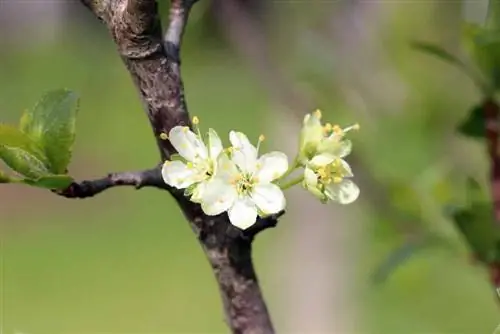
Some plum varieties are particularly susceptible to diseases and pests. A classic disease is pocket disease, which is easy to recognize due to its typical damage:
- Fruits grow banana-shaped
- a light green coating forms on the fruits
- Topping later turns grey, floury
- Fruits remain hard and inedible
The disease can develop, especially in rainy weather, and can only be combated by completely removing the affected parts of the plant. Another typical disease is plum rust, which can be recognized by black dots on the undersides of the leaves and yellowing of the leaves. Monilia fruit rot, on the other hand, appears as a white pustule on the plum and causes the fruit to turn black. In this case too, only the complete removal of all affected parts of the plant will help.
The most common pests that can affect plum trees include plum moths and aphids. Both should be combated in good time with the help of a mild pesticide. However, if you take optimal care of your plum tree, you will rarely have to deal with diseases and pests. Careful care ensures he althy growth of the tree - and lots of delicious plums with which the hobby gardener can sweeten the summer and autumn.

